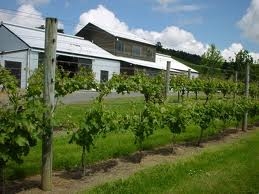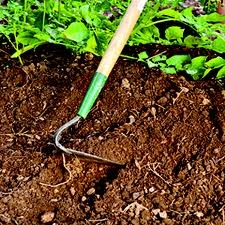
In February, your vines received eight to twelve inches of rain, depending on your location. The deluge was welcome but not even close to enough rain to say we are out of the woods. You can't put your grapevines on autopilot as you might do in wet years. You need a plan.
A smart draught plan starts with pruning, to adjust the crop size to match available water. In prior years, you might have left three buds per vine. This year, two would be wiser. If you didn't do this when you pruned, it's not too late. You can thin after flowering and fruit set.
You may have heard people talk about dry farming—growing grapes without irrigation—but that's a decision to make when you plant your vineyard, not as a response to drought. To dry farm, you need sufficient ground water and a rootstock that will send roots deep enough to reach it. Even dry-farmed Napa Valley vineyards may need irrigation this year as we haven't had enough rain to maintain ground water levels.
Grapevines are relatively drought tolerant, but insufficient water at crucial stages can compromise vine growth, fruit yield and quality. In the period between budbreak and flowering, avoiding water stress is critical. Vines use the water for root growth, establishing the canopy and determining the yield for this year and the next. Water stress between flowering and fruit set can result in poor fruit set, aborted fruit or smaller berries, all of which reduce yield. After fruit set, grapevines can tolerate moderate water deficits.
Before your first irrigation, make sure your system has no leaks andis operating efficiently. Irrigating at night will reduce evaporation loss by up to 10 percent.
Before irrigating,analyze the water content of your soil. Dig a few holes as deep as the longest roots. If the soil at the bottom of the hole is dry, you need to irrigate. If the soil is moist at the bottom, you don't.
Instead of growing a cover crop that takes water out of the soil, use mulch and compost to improve water retention. Control weeds that compete with vines for water. If you have dead or unproductive vines, don't replace them this year. Young vines require more water than established vines, so delay replanting until you know you can meet the new vines' water needs.
Be stingy with nitrogen fertilizer as nitrogen favors shoot growth over root growth, making vines more susceptible tolate-season drought. Monitor canopy size, limiting it to what's needed to ripen the crop.
Last but not least, thin fruit to reduce vine stress. Better to sacrifice some or all of the crop rather than permanently damage the grapevine.
Tomato Plant Sale: Napa County Master Gardeners will hold their second annual “Tomato Plant Sale and Education Day” on Saturday, April 19, in the South Oxbow parking lot on First Street in Napa. The sale will be held from 9:00 a.m. until sold out. All the seedlings have been started from seed and grown by Napa County Master Gardeners. More than 50 varieties of heirloom and hybrid tomato plants will be available. Master Gardeners will staff information tables on tomato support structures, common tomato pests and diseases, composting, good bug/bad bug displays and a mobile help desk. For a list of available tomato varieties, visit http://ucanr.org/ucmgnapa or call the Help Desk (hours below).
Workshop: Napa County Master Gardeners will conduct a workshop on “The Small Home Vineyard” on Saturday, March 29, from 9:30 am to 11:30 am, and from 12:30 pm to 2:30 pm. at the Yountville Community Center, 6516 Washington Street, Yountville. The morning session will focus on bud break to harvest. Learn the basics of managing a small vineyard including grape physiology, canopy management, vine nutrition, fertilization, irrigation and cover crop. The afternoon session will focus on identifying and managing the most common vineyard pests, especially powdery mildew. To register,call the Parks & Recreation Department at 707-944-8712 or visit its web site.
Master Gardeners are volunteers who help the University of California reach the gardening public with home gardening information. Napa County Master Gardeners ( http://ucanr.org/ucmgnapa/) are available to answer gardening questions in person or by phone, Monday, Wednesday and Friday, 9 a.m. to Noon, at the U. C. Cooperative Extension office, 1710 Soscol Avenue, Suite 4, Napa, 707-253-4143, or from outside City of Napa toll-free at 877-279-3065. Or e-mail your garden questions by following the guidelines on our web site. Click on Napa, then on Have Garden Questions? Find us on Facebook under UC Master Gardeners of Napa County.
Napa County Master Gardeners welcome the public to visit their demonstration garden at Connolly Ranch on Thursdays, from 10:00 a.m. until noon, except the last Thursday of the month. Connolly Ranch is at 3141 Browns Valley Road at Thompson Avenue in Napa. Enter on Thompson Avenue.

If so, maybe these plants were trying to tell you something. Your soil may require some help providing the structure and nutrients that plants need to thrive.
You can't just put your plants in dirt and expect them to flourish. Remember: there is a difference between soil and dirt. Dirt is what you get on your clothes and hands while working in the soil. Soil is made up of elements that have been decomposing since the earth was created.
Soil is composed of bedrock and mountain stones broken down over eons by wind and rain. Since Napa Valley is in a volcanically active area, much of our soil is made up of volcanic matter deposited by the river. In addition, plants, animals and bacteria contribute to the composition of our soils. We have heard a lot about how chemicals used in the garden do not break down in the soil but remain in our streams and rivers. Natural materials are a better choice.
Consider having your soil tested to see what minerals it contains, what minerals it lacks, and how much fertilizer you need. Online merchants sell bacteria and mycorrhizae (beneficial fungi) that can help restore life to your soil. Adding manure from cows, horses or other grain-eating animals will improve the soil, but be sure the manure has been aged to kill any weed seeds. Otherwise you can expect a major weed crop wherever you spread the manure.
I live on the valley floor, where the soil includes a lot of silt deposited by the Napa River during flooding. This silt, which is clay like, creates a hard layer on top of the soil when it dries. Where the river floods its banks, this layer can be two to three inches deep or more.
Clay soils hold a lot of water but don't provide much opportunity for plants to grow. The soil particles are tiny. For comparison, if a clay particle were the size of a penny, then a particle of sand would be the size of a house. The area between soil particles is where air and water reside, and plants need both to grow. Plants in soggy soil often die of root rot.
One of the easiest ways to improve clay soil is to add compost and other organic matter. Compost is composed of organic matter that has broken-down to form humus. It has little nutrient value but it does aerate the soil and improve drainage. In contrast, worm compost (vermicompost)—the castings produced by worms that eat food scraps and other organic matter—is a nutrient-rich soil amendment. Earthworms happily munch on kitchen scraps, lawn clippings, newspaper, even cardboard.
If you would like to learn more about composting, attend one of the nine composting workshops that will be conducted this year by Napa County Master Gardeners in conjunction with partnering agencies. One workshop is entirely devoted to worm composting, and the workshop on April 12 will be conducted in Spanish. Register online at www.cityofnapa.org/compost. You can help your soil produce the healthiest plants in town. To learn more about the soil food web, I recommend the book Teaming with Microbes: The Organic Gardener's Guide to the Soil Food Web by Jeff Lowenfels and Wayne Lewis.
Workshops: Napa County Master Gardeners will conduct a workshop on “Warm-Season Veggies” on Saturday, March 15, from 9:30 am to 11:30 am, at the University of California Cooperative Extension, 1710 Soscol Avenue, Napa. Prepare now for your most successful vegetable garden ever. Learn what to plant from seed, how to choose transplants, and when to plant for a bountiful harvest from spring into fall. Online registration (credit card only)
Mail in registration (cash or check only)
Napa County Master Gardeners will conduct a workshop on “The Small Home Vineyard” on Saturday, March 29, from 9:30 am to 11:30 am, and from 12:30 pm to 2:30 pm. at the Yountville Community Center, 6516 Washington Street, Yountville. The morning session will focus on bud break to harvest. Learn the basics of managing a small vineyard including grape physiology, canopy management, vine nutrition, fertilization, irrigation and cover crop. The afternoon session will focus on identifying and managing the most common vineyard pests, especially powdery mildew. To register,call the Parks & Recreation Department at 707-944-8712 or visit its web site.
Napa County Master Gardeners welcome the public to visit their demonstration garden at Connolly Ranch on Thursdays, from 10:00 a.m. until noon, except the last Thursday of the month. Connolly Ranch is at 3141 Browns Valley Road at Thompson Avenue in Napa. Enter on Thompson Avenue.
Master Gardeners are volunteers who help the University of California reach the gardening public with home gardening information. Napa County Master Gardeners ( http://ucanr.org/ucmgnapa/) are available to answer gardening questions in person or by phone, Monday, Wednesday and Friday, 9 a.m. to Noon, at the U. C. Cooperative Extension office, 1710 Soscol Avenue, Suite 4, Napa, 707-253-4143, or from outside City of Napa toll-free at 877-279-3065. Or e-mail your garden questions by following the guidelines on our web site. Click on Napa, then on Have Garden Questions? Find us on Facebook under UC Master Gardeners of Napa County.

